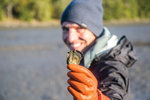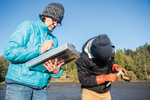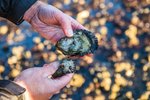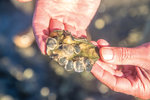Just an hour after the sun had risen, biologist Neil Harrington reached his bare hand into the icy cold water of Discovery Bay at low tide.
Through the murky tidal flow he pulled out a small oyster.
This item is available in full to subscribers.
We have recently launched a new and improved website. To continue reading, you will need to either log into your subscriber account, or purchase a new subscription.
If you had an active account on our previous website, then you have an account here. Simply reset your password to regain access to your account.
If you did not have an account on our previous website, but are a current print subscriber, click here to set up your website account.
Otherwise, click here to view your options for subscribing.
* Having trouble? Call our circulation department at 360-385-2900, or email our support.
Please log in to continue |
|




Just an hour after the sun had risen, biologist Neil Harrington reached his bare hand into the icy cold water of Discovery Bay at low tide.
Through the murky tidal flow he pulled out a small oyster.
Finding an oyster in these parts is not unusual. But this was not your typical oval-shaped Pacific oyster. Measuring just two to three inches across, the small round oyster in the palm of Harrington’s hand was an Olympia, the oyster that is native to the Pacific Northwest.
Overharvesting and pollution have made the Olympia oyster a rare sight. But Harrington, a biologist with the Jamestown S’Klallam tribe and a member of Jefferson County’s Marine Resources Committee (MRC), is one of the many conservationists across the state working to restore the species, and the unique habitat their colonies create in our waters.
Catching an early low tide on Oct. 10, Harrington and fellow MRC member Sarah Fisken, who works for the Washington Sea Grant, pulled on their rubber boots and headed out into Discovery Bay to search for Olympia oyster spat, part of a 10-year project by the MRC to protect and restore the population of Olympia oysters in Discovery Bay.
ONCE IN ABUNDANCE
Before European settlers landed in Western Washington, Olympia oysters grew in abundance throughout the Puget Sound, including in Discovery Bay, where they were a source of food for the S’Klallam people.
“There were probably 50 acres of Olympia oyster habitat out here in Discovery Bay,” Harrington said.
In 1845 European settlers began to populate the Northwest. Shortly after, in 1850, the first Olympia oysters were shipped from Washington to feed miners in California during the Gold Rush.
In 1895, the Washington legislature passed the Bush and Callow Acts, which allowed for the privatization of tidelands for shellfish cultivation, which caused a rise in Olympia oyster harvesting. To replace the declining number of Olympia oysters, in 1902, the non-native Pacific oysters were introduced from Japan.
In 1927, the Shelton pulp mill opened and dumped toxic waste into Puget Sound, killing off many of the nearby remaining native oyster populations. That mill remained open until 1957.
Since then, the Olympia oyster has been scarce. In 1998, the Washington Department of Fish and Wildlife named the native oysters a candidate to be on the threatened, endangered and sensitive species list.
In 2010, the Puget Sound Restoration Fund joined with several groups, such as the MRC, on a 10-year endeavour to rebuild dense breeding populations of Olympia oysters.
According to the PSRF’s research, at the start of this 10-year project, only 4% of the Olympia oyster core populations remained in Puget Sound.
Only 155 acres were documented to have Olympia oysters, compared to a historical 10,000 acres of dense assemblages of oysters.
“The initial intent was more about restoring the species itself,” said Cheryl Lowe, WSU Extension’s water resource manager and the MRC coordinator.
“Over time, we realized this is more of a habitat restoration project.”
Restoring the population of oysters also restores a lost habitat. When oysters grow in dense accumulations, they create a complex nearshore habitat for a variety of organisms and help the ecosystem with their natural filtration and larval production.
PRSF was hoping to restore 100 acres of Olympia oyster habitat by 2020. With the help of groups like MRC, by the end of 2019, they will have completed 84 acres of habitat enhancements throughout the Puget Sound.
LOCAL RESTORATION
Jefferson County’s MRC is one of seven Marine Resources Committees in the Northern Puget Sound region that were formed in 1998 under the Northwest Straits Marine Conservation Initiative.
Now in its 20th year, Jefferson County’s MRC is a citizen-based, volunteer committee that focuses on Puget Sound restoration and water quality projects.
One of their current projects is partnering with the greater statewide initiative to improve Olympia oyster habitat.
A small but persistent population of Olympia oyster has survived in the tidelands of Discovery Bay. Since 2013, the MRC has been working on a half-acre habitat enhancement project in this area.
Doing surveys of the area, they found that the current population was healthy, but not able to expand much due to limited suitable surfaces for them to attach to and grow on, especially oyster shells.
Olympia oysters send out planktonic larvae, which float through the water for about five to seven days before they find a surface such as wood or oyster shells to cling onto and grow into oyster spat and later into full-sized oysters.
The MRC decided one way to possibly increase the population of Olympia oysters was to add scattered oyster shells in the bay, so that there would be more surfaces for the oyster spat to grow.
In 2014, volunteers dispersed clean Pacific oyster shells on 1/4 acre of tide flats to test the effectiveness of this.
Larvae released from the nearby population settled on this shell in 2015 and 2016. Additional shell was added to the project site in 2016 to replace the shell that the tides had moved elsewhere.
Last spring, volunteers spread even more shell in the bay. On the chilly October morning, Harrington and Fisken headed out to see if the shell spread had any oysters on it.
“We want to know if this is an effective strategy for restoring Olympia oyster populations,” Harrington said.
Surveying six areas where shell was spread, Harrington and Fisken picked up oyster shells from the water and counted the number of Olympia oysters growing.
In some areas, the shells did not pick up very many oysters. But others were packed with the tiny growing bivalves.
“Sometimes I call them charismatic cryptofauna,” Harrington joked, in a reversal of the term “charismatic megafauna” used to describe mass-media stars like the grizzly bear, as he used a set of calipers to measure oysters that were just millimeters long.
Even though it occasionally took sharp eyes to find the tiny oysters in the crevices of the oyster shells, their findings were overall positive.
“I’m excited that the results we saw at our first site we are now seeing repeated at the lagoon site,” Lowe said. “We see this as a long-term project. A one-time action will not be enough.”
RESTORING THE WATER
Working overtime to increase the amount of Olympia oysters growing in Discovery Bay will have major impacts on the quality of water and habitat in the bay.
Oysters are filter feeders and help keep the water clean and clear for eelgrass and aquatic life.
But ocean acidification threatens the non-native Pacific oyster populations of Washington, as a decrease in calcium in the water means it is harder for them to grow their shells.
“Olympia oysters have a higher tolerance for ocean acidification,” Lowe said. “They grow more slowly and form a denser shell. They are adapted to not needing all their calcium at once, like the Pacific oyster.”
Not only that, but Olympia oysters create a habitat that benefits a lot of other species.
“They create a complex structure that comes from layers and layers of oysters growing over each other,” Lowe said. “It’s a different complexity from the Pacific oyster reef.”
This habitat supports the life of forage fish and other intertidal creatures like chiton, barnacles and isopods.
“It’s a biogenic habitat,” Harrington said. “One that is created by the organisms that are living there.”
A healthy intertidal habitat created by Olympia oysters only increases the health of the rest of the oceans—more food in the intertidal zones for fish and crabs to eat means more food for marine mammals like whales.
For Harrington and Fisken, being part of the MRC and participating in a statewide restoration project like this is an exciting opportunity.
“Being part of the MRC provides an opportunity for the average citizen to do some good,” Harrington said. “We do a wide range of stuff from outreach and education to restoration. It’s a way people can connect to do good for the Puget Sound.”
The committee meets at 6 p.m. on the first Tuesday of every month at the Port Commission building. The meetings are open to the public.
They are also occasionally looking for new members. To learn more about getting involved, or to sign up for their newsletter, go to jeffersonmrc.org.